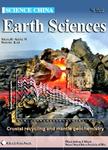Structure of the internal isochronous layers at Dome A,East Antarctica
Structure of the internal isochronous layers at Dome A,East Antarctica作者机构:Ocean University of China College of Marine Environment Qingdao 266100 China SOA Key Laboratory for Polar Science Polar Research Institute of China Shanghai 200136 China
出 版 物:《Science China Earth Sciences》 (中国科学(地球科学英文版))
年 卷 期:2011年第54卷第3期
页 面:445-450页
核心收录:
学科分类:07[理学] 0705[理学-地理学] 070501[理学-自然地理学]
基 金:supported by National Natural Science Foundation of China (Grant Nos. 40906101 and 40476005) National Basic Research Program of China (Grant No. 2006BAB18B01) IPY Chinese Programme (Grant No. IPY2008-P050400101) Polar Strategy Research Foundation in China (Grant No. 20070215)
主 题:East Antarctic Ice Sheet Dome A ice radar internal layers deep ice core
摘 要:Dome A (Kunlun Station) is considered a likely place for finding an ice core record reaching back to one million years. The internal isochronous layering of the Antarctic Ice Sheet, revealed by ice radar, is a prerequisite for selecting sites for deep ice core drilling that can be used for studying the paleoclimatic record. In 2004/2005, during the 21st Chinese National Antarctic Research Expedition (CHINARE 21), a 200-km long, continuous radar profile was obtained across Dome A. The internal layers along the profile were derived from the stratigraphy detected by the radar. The morphology of the isochronous layers shows that: (1) The internal layers in the shallow ice sheet (0-500 m) are generally flat, with no more than 50 m of layer intervals, and have typical synclines and anticlines in some localized regions. (2) At 500-2000 m below the surface of the ice sheet, the layers appear as bright layers , and the width of the layer intervals expands to 50-100 m. (3) When the basal topographic wavelengths are approximate to the thickness of the ice (3 km), the traced internal layers, with localized bumps or concave folds, are asymptotic parallel to the subglacial topography. For the longer topographic wavelengths (~20 km) wider than the thickness of the ice, the layers do not rise and fall with the basal topography. The internal layers surrounding some mountain peaks representing the most extreme variation in the terrain are sharply disturbed by the subglacial topography. (4) Layer discontinuity and fracture were detected in the basal ice sheet. Finally, by combining this new information with that derived from existing data regarding ice thickness, we were able to select three potential sites for reconstructing the age-depth relationship of the ice core.



